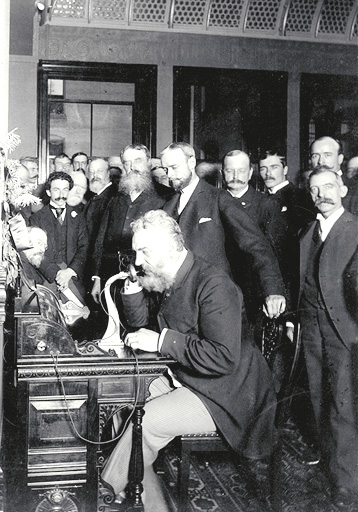The following is from the book Myths: Fact and Fiction about Teaching and Learning by Israel Galindo. How well do you know fact from fiction?
Myth: Alexander Graham Bell invented the telephone.

Alexander Bell (sitting) in 1892
TRUTH: A. E. Bell did not invent the telephone. Bell was using already existing items trying to make an instrument to help the deaf hear. He did, however, beat Elisha Gray to the patent office by only two hours. Gray sued and lost.
Myth: In order to motivate students, we should praise them as often as we can. The teacher should strive to praise the student constantly and at every opportunity.
TRUTH: Giving constant praise to learners has the opposite of the desired effect on learner motivation. In fact, the more constant the praise, the less it is valued by the learner and the less it’s impact on learner motivation, behavior, or esteem.
The key is to learn to give effective praise. Effective praise are those communications that increase the chances for student motivation and that desirable conduct will be repeated and undesirable conduct eliminated. In lower grades, a student will be motivated and good behavior will be reinforced even if it is general, noncontingent, or flawed. But in the higher grades, for youth and adults, praise will motivate and affect conduct if it is specific, low key, sincere, or used contingently.
For example, research on the effect of praise on students revealed that learners who are praised for things they know everyone else gets praised for are not likely to attribute the praise to anything special about themselves, thereby lowering self-esteem. Also, praise that is consistently contingent on success will be taken as feedback that success has been achieved, thereby smothering motivation for further or real achievement.
Like any other skill in the art of teaching, praising students effectively is learned through practice. Below are six characteristics of effective praise:
1. It is delivered contingently.
2. It specifies the particulars of the accomplishment.
3. It shows spontaneity, variety, and other signs of credibility.
4. It rewards attainment of specified. performance criteria (including effort)
5. It provides information to students about their competence or the value of their accomplishments.
6. It uses students’ own prior accomplishments as the context for describing present accomplishment.
The key to using praise effectively with learners is to praise well rather than often.
You can order a copy of the book Myth: Fact and Fiction about Teaching and Learning by Israel Galindo (ISBN 0-9715765-4-8) directly from Educational Consultants.

